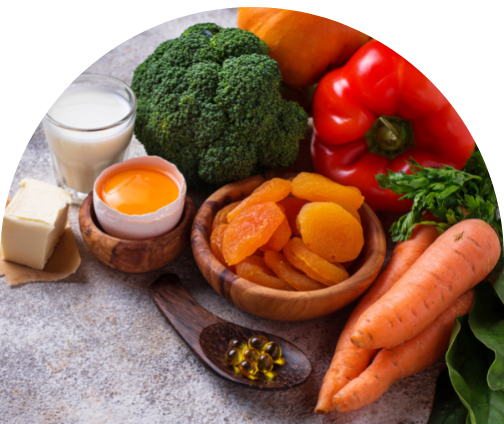Discover the Top 5 Nutrient Deficiencies and How You Can Reverse Them with Your Diet
“You are what you eat” is a very famous saying… but have you heard the more accurate version?
“You are what you eat and absorb.”
There’s no doubt nutrition plays a role in fertility outcomes and having a healthy pregnancy for both men and women. A big focus of our work with clients involves assessing their nutrient deficiencies and then addressing them through diet first and foremost.
It’s not as simple as knowing you need more Vitamin D, then going to Costco or the corner drug store and buying a huge bottle of “Vitamin D” pills from the shelf. Sometimes our bodies can’t even absorb the form of the nutrient that is in those bottles.
We can’t discuss resolving nutrient deficiencies to improve fertility without considering nutrient absorption.
Nutrient absorption is important because it’s possible to eat a variety of highly nutrient-dense foods but not get the full benefit from these nutrients simply because they pass right through you and are not absorbed from those foods.
Not absorbing nutrients is similar to not getting them in the first place. Nutrients can’t help your fertility if they never truly make it inside to do the work they need to do. Not absorbing enough of all the essential nutrients can lead to a negative impact on your fertility (that’s why they’re called essential).
According to a recent study published in the journal Nutrients, researchers found that “Nearly one-third of the U.S. population is at risk of deficiency in at least one vitamin, or has anemia.” The top five most common nutrient deficiencies were for Vitamins B6, B12, C, and D, and the mineral iron. Each of these common deficiencies does play a role in the reproductive process, from egg and sperm health to regulation of hormones, to the overall proper function of the reproductive system.
Your digestive system is how your body takes the essential nutrients from your food and absorbs them so they can be used for growth, maintenance, energy, healing, overall good health, and of course, fertility. For example, Vitamin B6 & Vitamin B12 are essential for producing sperm and eggs, and Vitamin C is an antioxidant that helps protect the eggs and sperm from damage. The same goes for iron which is important for forming red blood cells, which transport oxygen to the reproductive organs. Before nutrients can get where they need to go, they must first be removed from the food and absorbed into your body so that they can be circulated to get where they need to go.
In this blog post, we’ll go over some of our proven strategies for making nutrients more absorbable so your reproductive system can get the raw materials it needs to operate well. But first, why are some nutrients hard to absorb?
Why some nutrients are harder to absorb
Women who are seeking to get pregnant (and their partners) need to get enough of all of the essential nutrients for good health. This includes macronutrients (e.g., protein, carbohydrates, and healthy fats) and micronutrients (e.g., vitamins and minerals). Absorption and digestion of nutrients can be tricky because there are so many different foods and nutrients.
Bioavailability and nutrient absorption for fertility
In the functional fertility world, how much of a nutrient is absorbed and can be used or stored in the body is called nutrient bioavailability. This describes how available the nutrient is for our biological use.
There are three main steps to digesting the food you eat: breaking it down, absorbing the nutrients, and eliminating waste. That’s why your digestive system provides a long, diverse journey for food to travel once it’s eaten.
For example, your stomach is full of digestive juices (e.g., acid, enzymes) to break food into smaller pieces. Then, as your food starts moving through your small intestine, your liver and pancreas add alkaline bile (to neutralize the acid), as well as other enzymes to break down other components of food. Your small intestine is responsible for most—but not all—of the absorption of nutrients into your body. The final journey is through the large intestine, home to your friendly gut microbes (helpful bacteria and other tiny microorganisms). These microbes can break down (or ferment) some of the toughest nutrients that have made it this far intact (some fibers). The large intestine also absorbs some nutrients and water.
Whatever nutrients don’t get absorbed—because they weren’t broken down small enough, or were complexed with anti-nutrients, or because the digestive tract itself couldn’t do its best work—is eliminated as waste. It’s natural and healthy to eliminate a lot of what you’ve eaten, but ideally, the waste should have very little nutrition left in it. You want most of the essential nutrients to be absorbed so your body can use them for your best health.
Despite the diverse and complex processes that your body uses to absorb and digest as many nutrients from foods as possible, sometimes it can use some help. Some people have food intolerances or digestive issues that result in the malabsorption of certain nutrients. Plus, there are some nutrient-nutrient interactions and anti-nutrients found in foods that can reduce your ability to absorb them.
The good news is research shows that some very interesting things can increase nutrient bioavailability without supplementation. By eating certain nutrients together—or apart, or certain foods cooked—or raw, you can enjoy the same foods but in a more nutritionally efficient, bioavailable way.
We firmly believe you can’t supplement a bad lifestyle. It is important to speak to your healthcare professional as you figure out what deficiencies you have and how to best support and resolve them through a combination of diet and supplementation.
If you’re interested in learning more about what we offer,
We help our clients address their nutrient deficiencies, and our formula has over an 80% success rate in those who are ready and commit to our process.
Tips to get more nutrients from the same foods and resolve your nutrient deficiencies for better fertility outcomes
Here are some simple strategies to get more nutrition from the foods you enjoy.
Get more Vitamin C: Enjoy these fresh foods
Vitamin C is one of the most common vitamin deficiencies in the United States. This powerful antioxidant helps reduce the negative impact of free radicals in women. It also helps regulate the menstrual cycle and promote normal ovulation. For men, Vitamin C can help improve the mobility, quality, and number of sperm.
Foods that are rich in Vitamin C include fruits and vegetables. Some of the highest sources of Vitamin C are bell peppers, citrus fruits (and their juices), kiwis, broccoli, and strawberries.
Vitamin C is an antioxidant that is water-soluble and destroyed by heat. This means that Vitamin C levels are highest when the food is fresh and raw (or cooked as little as possible).
Strategy: to maximize the Vitamin C levels in your fruits and vegetables, try to eat them as fresh and raw as possible. If you enjoy them cooked, do so minimally by lightly steaming them.
Get more iron: Enjoy iron-rich foods with—and without—these
Iron is another common mineral deficiency, and women with low iron are more likely to exhibit symptoms like a lack of ovulation and poor egg health. Low iron levels during pregnancy can also be dangerous.
Some iron-rich foods are seafood, beans and lentils, liver, spinach, and tofu. Some breads and cereals are fortified with iron. Iron is found in two forms: heme (in animal-based foods) and non-heme (in plant-based foods). Heme iron is more bioavailable and more easily absorbed than non-heme. This means that the iron in plants is harder to absorb, but there are some simple tips you can use to absorb more.
Strategy: Iron absorption can be enhanced when consumed with Vitamin C-rich foods and away from tannin-containing drinks like tea and coffee.
This means enjoy your beans, lentils, spinach, or tofu with a Vitamin C-rich food in the same meal. For example, add bell peppers, orange wedges, or berries to your spinach salad. And enjoy your tea or coffee—not with, but—between your iron-rich meals.
Get more fat-soluble vitamins
Vitamin A
Vitamin A has been shown to play a role in fertilization and embryo development. We can find Vitamin A in liver, seafood, eggs, and fortified dairy.
Pro-Vitamin A (beta-carotene) is found in fruits and vegetables, especially orange ones like sweet potatoes and carrots, and dark green leafy ones like spinach and kale. Because of the way beta-carotene is stored in the plant cells, not all of it is as bioavailable as Vitamin A in animal-based foods.
Strategy: Unlike Vitamin C, Vitamin A is fat-soluble and becomes more bioavailable when cooked with orange and dark green plant-based sources.
Vitamin D
Vitamin D is essential for fertility and has been associated with higher odds of conception and helping women going through fertility treatments get better results, and for men, it has been shown to impact sperm motility and overall sperm health.
Vitamin D also helps reduce inflammation and helps to regulate the immune system and metabolism. Known as the sunshine vitamin because your skin makes Vitamin D when exposed to UV light, Vitamin D is also naturally found in a few foods.
Strategy: Incorporate seafood, mushrooms exposed to UV light, egg yolks, and some fortified dairy into your diet for more Vitamin D.
Vitamin E
Vitamin E is an antioxidant vitamin that can increase cervical mucus, which helps a fertilized egg stay attached to the uterus and ultimately boosts fertility.
Strategy: Eat foods with high levels of Vitamin E, including whole grains, nuts and seeds, and their butters and oils (e.g., wheat germ oil, almond butter).
Vitamin K2
Vitamin K2 has been shown to benefit PCOS and prenatal development in women and help with testosterone production and sperm count in men. Bacteria mostly make vitamin K2, so it’s found in fermented foods.
Strategy: Incorporate yogurt, cheese, and sauerkraut into your diet.
These four fat-soluble vitamins can be fairly bioavailable on their own, but a simple tip can help enhance absorption even more: get enough healthy fat. This means cooking your vegetables with a bit of healthy oil or pairing them with a nutritious dip or dressing to help you absorb more of these essential fat-soluble vitamins.
Get more calcium: Be sure to have a regular supply of Vitamin D
In the fertility context, calcium helps create an alkaline environment in the reproductive tract which supports the movement of the sperm toward the egg.
Some of the plant sources of calcium have lower bioavailability because they contain anti-nutrients like oxalate and phytic acid. The amount of calcium absorbed from these foods is increased with Vitamin D intake. While you don’t need to get Vitamin D in the same meal as a calcium-rich one, getting enough vitamin D every day is key—whether that means eating Vitamin D-rich foods with a bit of healthy fat or going outside in the sun.
Strategy: The largest sources of calcium in the North American and European diets are milk and dairy products. You can also get calcium from fruits and vegetables (e.g., kale, spinach, broccoli), as well as mineral water.
Get more lycopene: Cooking tomatoes brings out this bioactive nutrient
Lycopene has been shown to help with sperm mobility. This nutrient is similar to beta-carotene, but it is not considered essential. Studies show that lycopene may help reduce the risk of heart disease and some cancers like prostate cancer. Lycopene is a health-promoting antioxidant found in red and dark green fruits and vegetables such as tomatoes, pink grapefruit, and watermelon.
Like Vitamin A above, cooking tomatoes and enjoying them with a little bit of healthy fat can improve your absorption of lycopene.
Strategy: Enjoy cooked tomato products like ketchup (an organic low sugar version), tomato juice, and pasta sauce (ideally with gluten-free pasta).








